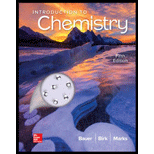
(a)
Interpretation:
The number of moles of
(a)
Explanation of Solution
The molar mass of
The number of moles of ammonia present is determined as follows.
Here,
The molar mass of
Therefore, there is
(b)
Interpretation:
The number of formula units of
(b)
Explanation of Solution
The number of formula units present is determined as follows.
Here,
The molar mass of
Therefore, there are
(c)
Interpretation:
The number of
(c)
Explanation of Solution
To calculate the number of
There are
Therefore, there are
(d)
Interpretation:
The number of moles of
(d)
Explanation of Solution
To calculate the number of moles of
Since one mole of carbonate ion is required for one mole of sodium carbonate hence, the moles of carbonate is the same as that of moles of sodium carbonate that is
Want to see more full solutions like this?
Chapter 4 Solutions
Introduction To Chemistry 5th Edition
- 1. Which of the following hydrocarbons has the highest mass percentage of carbon? methane, CH4 ethane, C2H6 propane, C3H8 butane, C4H10arrow_forwardYou have a pure sample of apholate, C12H24N9P3, a highly effective commercial insecticide. Calculate the molar mass of apholate. Calculate the mass of N in 100. g apholate. A sample containing 250.0 mg apholate is sprayed on an agricultural field. Calculate the mass of phosphorus in this sample of apholate; express your result in grams. Calculate the number of phosphorus atoms in this sample of apholate.arrow_forwardArrange the following substances in order of increasing mass percent of nitrogen. a. NO b. N2O c. NH3 d. SNHarrow_forward
- opical hydrocortisone is often used to treat a variety of skin conditions, such as insect bites, eczema, and rashes. Each molecule of hydrocortisone contains 21 atoms of carbon (plus other atoms). The mass percentage of carbon in hydrocortisone is 69.5 8%. What is the molar mass of hydrocortisone?arrow_forwardCalculate the mass percent of each element in the following compounds: (a) C8H10N2O2, caffeine (b) C10H20O menthol (c) CoCl2 6 H2Oarrow_forwardExpress the composition of each of the following compounds as the mass percents of its elements. a. formaldehyde, CH2O b. glucose, C6H12O6 c. acetic acid, HC2H3O2arrow_forward
- Phenol is a compound of carbon, hydrogen, and oxygen used commonly as a disinfectant. Combustion of a 175-mg sample of phenol yielded 491 mg CO2 and 100. mg H2O. Calculate the empirical formula of phenol. Identify what other information is needed to determine whether the empirical formula is the actual molecular formula.arrow_forwardCalculate the molar mass (in grams/mol) of (a) osmium metal, the densest naturally occurring element. (b) baking soda, NaHCO3. (c) vitamin D, C28H44O, required for healthy bones and teeth.arrow_forwardThe active ingredient in Pepto-Bismo® (an over- the-counter remedy for an upset stomach) is bismuth sub-salicylate, C7H5BiO4. Analysis of a 1.7500-g sample of Pepto-Bismol yields 346 mg of bismuth. What percent by mass is bismuth subsalicylate in the sample? (Assume that there are no other bismuth-containing compounds in Pepto-Bismol.)arrow_forward
 Chemistry: Principles and PracticeChemistryISBN:9780534420123Author:Daniel L. Reger, Scott R. Goode, David W. Ball, Edward MercerPublisher:Cengage Learning
Chemistry: Principles and PracticeChemistryISBN:9780534420123Author:Daniel L. Reger, Scott R. Goode, David W. Ball, Edward MercerPublisher:Cengage Learning Chemistry & Chemical ReactivityChemistryISBN:9781337399074Author:John C. Kotz, Paul M. Treichel, John Townsend, David TreichelPublisher:Cengage Learning
Chemistry & Chemical ReactivityChemistryISBN:9781337399074Author:John C. Kotz, Paul M. Treichel, John Townsend, David TreichelPublisher:Cengage Learning Chemistry & Chemical ReactivityChemistryISBN:9781133949640Author:John C. Kotz, Paul M. Treichel, John Townsend, David TreichelPublisher:Cengage Learning
Chemistry & Chemical ReactivityChemistryISBN:9781133949640Author:John C. Kotz, Paul M. Treichel, John Townsend, David TreichelPublisher:Cengage Learning Chemistry: The Molecular ScienceChemistryISBN:9781285199047Author:John W. Moore, Conrad L. StanitskiPublisher:Cengage Learning
Chemistry: The Molecular ScienceChemistryISBN:9781285199047Author:John W. Moore, Conrad L. StanitskiPublisher:Cengage Learning
 ChemistryChemistryISBN:9781305957404Author:Steven S. Zumdahl, Susan A. Zumdahl, Donald J. DeCostePublisher:Cengage Learning
ChemistryChemistryISBN:9781305957404Author:Steven S. Zumdahl, Susan A. Zumdahl, Donald J. DeCostePublisher:Cengage Learning





